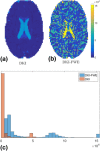Diffusion kurtosis imaging with free water elimination: A bayesian estimation approach
- PMID: 29393531
- PMCID: PMC5947598
- DOI: 10.1002/mrm.27075
Diffusion kurtosis imaging with free water elimination: A bayesian estimation approach
Abstract
Purpose: Diffusion kurtosis imaging (DKI) is an advanced magnetic resonance imaging modality that is known to be sensitive to changes in the underlying microstructure of the brain. Image voxels in diffusion weighted images, however, are typically relatively large making them susceptible to partial volume effects, especially when part of the voxel contains cerebrospinal fluid. In this work, we introduce the "Diffusion Kurtosis Imaging with Free Water Elimination" (DKI-FWE) model that separates the signal contributions of free water and tissue, where the latter is modeled using DKI.
Theory and methods: A theoretical study of the DKI-FWE model, including an optimal experiment design and an evaluation of the relative goodness of fit, is carried out. To stabilize the ill-conditioned estimation process, a Bayesian approach with a shrinkage prior (BSP) is proposed. In subsequent steps, the DKI-FWE model and the BSP estimation approach are evaluated in terms of estimation error, both in simulation and real data experiments.
Results: Although it is shown that the DKI-FWE model parameter estimation problem is ill-conditioned, DKI-FWE was found to describe the data significantly better compared to the standard DKI model for a large range of free water fractions. The acquisition protocol was optimized in terms of the maximally attainable precision of the DKI-FWE model parameters. The BSP estimator is shown to provide reliable DKI-FWE model parameter estimates.
Conclusion: The combination of the DKI-FWE model with BSP is shown to be a feasible approach to estimate DKI parameters, while simultaneously eliminating free water partial volume effects. Magn Reson Med 80:802-813, 2018. © 2018 The Authors Magnetic Resonance in Medicine published by Wiley Periodicals, Inc. on behalf of International Society for Magnetic Resonance in Medicine. This is an open access article under the terms of the Creative Commons Attribution NonCommercial License, which permits use, distribution and reproduction in any medium, provided the original work is properly cited and is not used for commercial purposes.
Keywords: Bayesian estimation; diffusion kurtosis imaging; free water elimination; partial volume effects; shrinkage prior.
© 2018 The Authors Magnetic Resonance in Medicine published by Wiley Periodicals, Inc. on behalf of International Society for Magnetic Resonance in Medicine.
Figures








References
-
- Jensen JH, Helpern JA, Ramani A, Lu H, Kaczynski K. Diffusional kurtosis imaging: the quantification of non‐gaussian water diffusion by means of magnetic resonance imaging. Magn Reson Med 2005;53:1432–40. - PubMed
-
- Lu H, Jensen JH, Ramani A, Helpern JA. Three‐dimensional characterization of non‐Gaussian water diffusion in humans using diffusion kurtosis imaging. NMR Biomed 2006;19:236–47. - PubMed
-
- Le Bihan D, Mangin JF, Poupon C, Clark CA, Pappata S, Molko N, Chabriat H. Diffusion tensor imaging: concepts and applications. J Magn Reson Imaging 2001;13:534–546. - PubMed
-
- Tuch DS, Reese TG, Wiegell MR, Wedeen VJ. Diffusion MRI of complex neural architecture. Neuron 2003;40:885–895. - PubMed
Publication types
MeSH terms
Substances
LinkOut - more resources
Full Text Sources
Other Literature Sources
Medical

